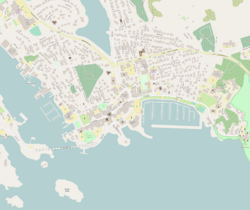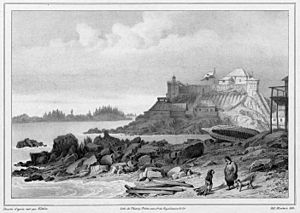Castle Hill (Sitka, Alaska) facts for kids
|
American Flag-Raising Site
|
|
 |
|
| Location | Between Harbor Road and Lincoln Street, Sitka, Alaska |
|---|---|
| Area | 3.6 acres (1.5 ha) |
| Built | 1804 |
| NRHP reference No. | 66000162 |
Quick facts for kids Significant dates |
|
| Added to NRHP | October 15, 1966 |
| Designated NHL | June 13, 1962 |
Castle Hill (Tlingit: Noow Tlein, Russian: Замковый холм) is also known as the American Flag-Raising Site. Today, it is called the Baranof Castle State Historic Site. This special place is a National Historic Landmark and a state park in Sitka, Alaska. The hill offers an amazing view over the city. It is a historic spot where Tlingit and Russian forts once stood. In 1867, Russian Alaska was officially given to the United States right here. Also, when Alaska became a state in 1959, the 49-star United States flag was first flown on this hill.
Contents
Exploring Castle Hill
Castle Hill is a large rock that stands about 60 feet (18 m) tall. It sits in a very important spot near Sitka Harbor. Even though some land was added around it in 1968, it still has a great view. The top of the hill is mostly flat, about 120 feet (37 m) long and 90 feet (27 m) wide. One side of the hill is very steep, while another side slopes more gently. There is a path with signs that explain the history of the area. This path makes it easy for visitors to reach the top.
A Look Back at Castle Hill's History
Before Europeans arrived, families from the Kiksadi clan of the Tlingit people lived on Castle Hill. In 1795, Alexander Andreyevich Baranov, a leader of the Russian-American Company, came to Sitka. He wanted to build a trading post on the hill. Instead, he built Redoubt St. Archangel Michael a few miles away in 1799. However, the Tlingit people destroyed this trading post in 1802.
Baranov returned to Sitka with more power in 1804. He took control of Castle Hill because the Tlingit people, who were outnumbered, had left. After a six-day battle called the Battle of Sitka, the Tlingit officially gave Castle Hill to the Russians.
Russian Control and the Governor's House
In 1806, the Russians moved the main office of the Russian-American Company to Sitka. Castle Hill became the center of their government in Russian Alaska until 1867. The Russians tore down the Tlingit houses on the hill. They then built several buildings on the hilltop over the years. The last and most important building was a two-story brick house with a dome on top. It was called the Governor's House and was built in 1836. Sadly, this building was destroyed by fire in 1894.
Transfer to the United States
In 1867, after the Alaska Purchase was agreed upon, Russian Alaska was officially handed over to the United States. This important ceremony took place on Castle Hill. After the transfer, commanders from the United States Army lived in the Russian-built Governor's House until 1877. The hill remained a key place for the U.S. government until the building burned down.
In 1898, the hill was given to the United States Department of Agriculture. They built a new structure on the hill, which was their main office in Alaska until 1932. This building was later used for different businesses before it was taken down in 1955. After that, the site was made into a park for the territory.
Alaska Becomes a State
When Alaska became the 49th U.S. state in 1959, Castle Hill was the place where the first 49-star U.S. flag in Alaska was raised. This ceremony was not official and was kept secret. In 1962, the site was named a National Historic Landmark. It was then added to the National Register of Historic Places in 1966. In 1965, a stone wall was built on the hill. Signs explaining the history were added, along with six cannons and a flagpole. Today, the state of Alaska manages this historic site as part of its state park system.




